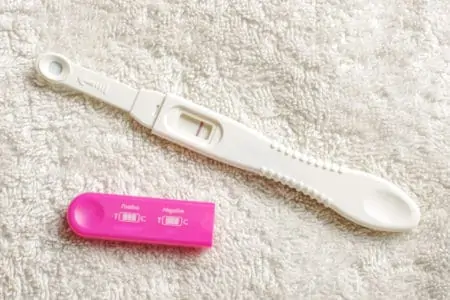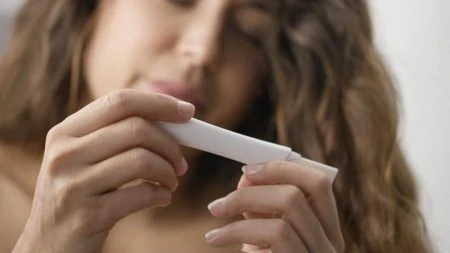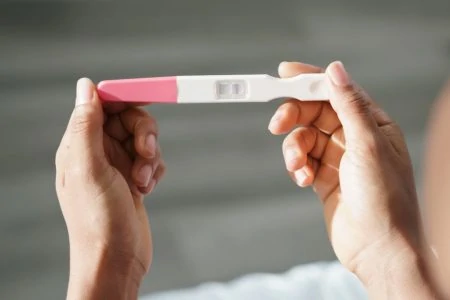Staring at a pregnancy test can be nerve-wracking. Is that a faint pink line, a shadow, or just wishful thinking?
You are not alone in the confusion. Interpreting a faint line is one of the most common challenges during the “two-week wait.” We will help you decipher whether that squinter is a positive result, an evaporation line, or something else entirely.
Here is everything you need to know about faint positive pregnancy tests.
Key Takeaways
- HCG detection: Tests react to human chorionic gonadotropin (HCG) in urine; faint lines usually indicate low levels found in early pregnancy.
- False alarms: Evaporation lines and indent lines can look like positives but lack color (pink or blue).
- Best test types: Pink dye tests are generally easier to read and less prone to misleading gray lines than blue dye versions.
- Next steps: If you see a faint line, wait 48 hours and retest; HCG should double, making the line darker.
How Pregnancy Tests Work
What actually turns that stick pink or blue? It comes down to a hormone called human chorionic gonadotropin, or HCG (1).
After conception, your baby’s placenta produces HCG to nourish the embryo. This hormone supports the main pregnancy drivers, estrogen and progesterone.
Test strips contain antibodies that react to HCG. When your urine hits the stick, the dye binds to the hormone if it is present. If there is no HCG, the dye passes through without sticking. If HCG is there, the dye activates, and a second line appears.
Not all tests are equal. Some are hyper-sensitive, while others require higher hormone levels to trigger a positive result. This sensitivity difference is often why you might see a faint line on one brand and a negative on another.
What Does a Faint Line Mean?
A faint line usually triggers a mix of excitement and anxiety. Here are the four most common reasons you might see one.
1. It Is Truly Positive
If the line has distinct color (pink or blue) and appeared within the time frame listed on the box, you are likely pregnant.
HCG levels double roughly every 48 hours in early pregnancy (2). If you test very early, such as 10 days past ovulation, your HCG levels may barely cross the test’s detection threshold. This results in a line that is visible but pale.
If you retest in two days, a viable pregnancy will usually produce a noticeably darker line.
2. It Is an Evaporation Line
An evaporation line (or “evap”) is a common nuisance with non-digital tests. Every test strip has a “test line” area where the antibody sits. As urine dries on the stick, it can leave a faint, colorless watermark.
How do you tell the difference?
- Evap Line: Usually colorless, grey, or white. It often appears after the testing window (10+ minutes) has passed.
- Positive Line: Has the color of the dye (pink or blue) and appears within the time limit.
To avoid this confusion, never read a test after the time limit specified in the instructions (3).
3. Chemical Pregnancy
A chemical pregnancy is a very early miscarriage that occurs shortly after implantation. It happens before an ultrasound can detect a gestational sac, usually around the 5th week.
In this scenario, an egg fertilizes and implants, triggering HCG production. This gives you a faint positive test. However, if the pregnancy is not viable, often due to chromosomal issues, it stops developing, and bleeding begins shortly after (4).
While emotionally difficult, chemical pregnancies are common and rarely impact your future fertility. Most women can conceive again immediately.
Some people are at higher risk for chemical pregnancies, including women above age 35 and those with medication conditions for which they are not getting the proper treatment. Speak to your doctor if you have any concerns about your medical condition and the risk of a chemical pregnancy.
Editor's Note:
Dr. Njoud Jweihan, MD4. Early Miscarriage
If you had a clearly positive test that has become faint over subsequent days, or if you are experiencing bleeding with a faint positive, you may be experiencing a pregnancy loss.
Miscarriages occur in 10 to 25 percent of known pregnancies. When a loss occurs, HCG levels do not disappear instantly. They drop gradually, meaning you might still see faint positive lines for days or weeks after the loss begins (5).
What To Expect
Blue Dye vs. Pink Dye: Which Is Better?
Go to any pharmacy, and you will see shelves packed with pink dye, blue dye, and digital options.
We strongly recommend sticking to pink dye tests.
Blue dye tests are notorious for confusing “indent lines.” The antibody strip on blue tests often leaves a visible grey shadow even when negative. Because the blue dye is dark, it is easy to mistake that grey shadow for a faint positive.
Pink dye tests usually offer a clearer contrast. If you see pink, it is likely positive. If you see a grey or white line, it is likely negative.
Digital tests remove the guesswork by saying “Pregnant” or “Not Pregnant,” but they are generally less sensitive. They typically require higher HCG levels, so they may show a negative result when a sensitive pink dye test would show a faint positive.
Morning or Evening Urine?
Does the time of day matter? Yes.
For the most accurate early results, use First Morning Urine (FMU). Your urine is most concentrated right after you wake up, meaning it contains the highest amount of HCG.
If you test in the evening, your urine is likely diluted by the water, coffee, or soda you drank throughout the day. This dilution can make a positive result look faint or even disappear completely.
If you must test at night, follow these tips:
- Hold it: Do not pee for at least 4 hours before testing to let HCG build up.
- Limit fluids: Stop drinking water a few hours before testing to avoid dilution.
- Trust the positive: If you get a positive at night with diluted urine, you are almost certainly pregnant.
- Ignore the negative: A negative result at night might just mean your urine was too watery. Retest in the morning.
What To Do if You Get a Faint Line
Staring at a faint line can feel like limbo. Here is your action plan:
1. Wait Two Days and Retest
HCG doubles every 48 to 72 hours. If that faint line is a true pregnancy, it should be noticeably darker in two days (6).
While waiting, act as if you are pregnant. Start taking prenatal vitamins and avoid alcohol.
2. Get a Blood Test
If the home tests remain ambiguous, call your doctor. They can perform a quantitative beta-HCG blood test.
Unlike home tests that give a “yes” or “no,” a blood test measures the exact amount of hormone in your system. A repeat blood test two days later can confirm if the numbers are rising correctly.
3. Watch for Pain
If you have a faint positive accompanied by severe abdominal pain or one-sided cramping, seek medical help immediately. These can be signs of an ectopic pregnancy, where the egg implants in the fallopian tube (7). This is a medical emergency.
Which Pregnancy Tests Are Most Sensitive?
If you are testing early (before your missed period), you need a test with high sensitivity. Sensitivity is measured in mIU/mL (milli-international units per milliliter). The lower the number, the earlier it can detect a pregnancy.
Here is a breakdown of sensitivity levels for common test brands:
| Test Name | Lowest HCG Detected |
| First Response Early Result | 6.3 – 25 mIU (Varies by batch) |
| AimStrip | 20 mIU |
| Clearblue Early Detection | 10 – 25 mIU |
| Wondfo Strips (Cheapies) | 25 mIU |
| Generic Store Brands (CVS, Target, etc.) | 25 mIU |
| Digital Tests (Clearblue, First Response) | 25 – 50 mIU |







